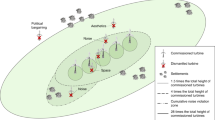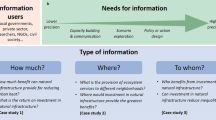Abstract
Cost-efficiency and public acceptance are competing objectives for onshore wind locations. The impact of ‘scenicness’ on these two objectives has been difficult to quantify for wind projects. We analyse the link between economic wind resources and beautiful landscapes with over 1.5 million ‘scenicness’ ratings of around 200,000 geotagged photographs from across Great Britain. We find evidence that planning applications for onshore wind are more likely to be rejected when proposed in more scenic areas. Compared to the technical potential of onshore wind of 1,700 TWh at a total cost of £280 billion, removing the 10% most scenic areas implies about 18% lower generation potential and 8–26% higher costs. We also consider connection distances to the nearest electricity network transformer, showing that the connection costs constitute up to half of the total costs. The results provide a quantitative framework for researchers and policymakers to consider the trade-offs between cost-efficiency and public acceptance for onshore wind.
This is a preview of subscription content, access via your institution
Access options
Access Nature and 54 other Nature Portfolio journals
Get Nature+, our best-value online-access subscription
$29.99 / 30 days
cancel any time
Subscribe to this journal
Receive 12 digital issues and online access to articles
$119.00 per year
only $9.92 per issue
Buy this article
- Purchase on Springer Link
- Instant access to full article PDF
Prices may be subject to local taxes which are calculated during checkout





Similar content being viewed by others
Data availability
The data employed in this paper can be accessed on Figshare at https://figshare.com/articles/dataset/Quantifying_the_trade-off_between_cost-efficiency_and_public_acceptance_for_onshore_wind/12998693. Source data can be accessed at the locations specified in the main text and the Methods.
References
Department of Business Energy Industrial Strategy. Energy and Climate Change Public Attitude Tracker, Wave 25 https://www.gov.uk/government/statistics/energy-and-climate-change-public-attitudes-tracker-wave-25 (2018).
YouGov, Renewable UK Survey http://d25d2506sfb94s.cloudfront.net/cumulus_uploads/document/3hx70b1nzc/RenewableUK_June18_GB_w.pdf (2018).
Bell, D., Gray, T., Haggett, C. & Swaffield, J. Re-visiting the ‘social gap’: public opinions and relations of power in the local politics of wind energy. Environ. Politics 22, 115–135 (2013).
Fast, S. et al. Lessons learned from Ontario wind energy disputes. Nat. Energy 1, 15028 (2016).
Boudet, H. S. Public perceptions of and responses to new energy technologies. Nat. Energy 4, 446–455 (2019).
Petrova, M. A. From NIMBY to acceptance: toward a novel framework—VESPA—for organizing and interpreting community concerns. Renew. Energy 86, 1280–1294 (2016).
Molnarova, K. et al. Visual preferences for wind turbines: location, numbers and respondent characteristics. J. Appl. Energy 92, 269–278 (2012).
Wolsink, M. Co-production in distributed generation: renewable energy and creating space for fitting infrastructure within landscapes. Landsc. Res. 43, 542–561 (2018).
Betakova, V., Vojar, J. & Sklenicka, P. Wind turbines location: how many and how far? Appl. Energy 151, 23–31 (2015).
Van der Horst, D. NIMBY or not? Exploring the relevance of location and the politics of voiced opinions in renewable energy siting controversies. Energy Policy 35, 2705–2714 (2007).
Schumacher, K. et al. Public acceptance of renewable energies and energy autonomy in different energy policy contexts: a comparative study in the French, German and Swiss Upper Rhine region. Energy Policy 126, 315–332 (2019).
Sonnberger, M. & Ruddat, M. Local and socio-political acceptance of wind farms in Germany. Technol. Soc. 51, 56–65 (2017).
Warren, C., Lumsden, C., O’Dowd, S. & Birnie, R. Green on green: public perceptions of wind power in Scotland and Ireland. J. Environ. Plan. Manag. 48, 853–875 (2005).
Department for Communities and Local Government. Final Decision on Scout Moor Wind Farm Application https://assets.publishing.service.gov.uk/government/uploads/system/uploads/attachment_data/file/625856/17-07-06_FINAL_DL_Scout_Moor_Wind_Farm.pdf (2017).
Seresinhe, C. I., Preis, T., MacKerron, G. & Moat, H. S. Happiness is greater in more scenic locations. Sci. Rep. 9, 4498 (2019).
Bornstein, R. D. & Johnson, D. S. Urban-rural wind velocity differences. Atmos. Environ. 11, 597–604 (1977).
Ueckerdt, F. et al. System LCOE: What are the Costs of Variable Renewables? https://doi.org/10.2139/ssrn.2200572 (2013).
Price, J., Mainzer, K., Petrović, S., Zeyringer, M. & McKenna, R. The implications of landscape visual impact on future highly renewable power systems: a case study for Great Britain. IEEE Trans. Power Syst. https://doi.org/10.1109/TPWRS.2020.2992061 (2020).
Dalla Longa, F. et al. Wind Potentials for EU and Neighbouring Countries: Input Datasets for the JRC-EU-TIMES Model JRC109698, EUR 29083 EN (Publications Office of the European Union, 2018); https://doi.org/10.2760/041705
Zeyringer, M. et al. Designing low-carbon power systems for Great Britain in 2050 that are robust to the spatiotemporal and inter-annual variability of weather. Nat. Energy 3, 395–403 (2018).
Ryberg, D. S., Tulemat, Z., Stolten, D. & Robinius, M. Uniformly constrained land eligibility for onshore European wind power. Renew. Energy 146, 921–931 (2020).
Staffell, I. & Pfenninger, S. Using bias-corrected reanalysis to simulate current and future wind power output. Energy 114, 1224–1239 (2016).
Bosch, J., Staffell, I. & Hawkes, A. Temporally-explicit and spatially-resolved global onshore wind energy potentials. Energy https://doi.org/10.1016/j.energy.2017.05.052 (2017).
Höltinger, S. et al. Austria’s wind energy potential – a participatory modeling approach to assess socio-political and market acceptance. Energy Policy 98, 49–61 (2016).
Jäger, T., McKenna, R. & Fichtner, W. The feasible onshore wind energy potential in Baden-Württemberg: a bottom-up methodology considering socio-economic constraints. Renew. Energy 96, 662–675 (2016).
Harper, M. et al. Assessing socially acceptable locations for onshore wind energy using a GIS-MCDA approach. Int. J. Low-Carbon Technol. 14, 160–169 (2019).
Jobert, A., Laborgne, P. & Mimler, S. Local acceptance of wind energy: factors of success identified in French and German case studies. Energy Policy 35, 2751–2760 (2007).
Kontogianni, A., Tourkolias, C., Skourtos, M. & Damigos, D. Planning globally, protesting locally: patterns in community perceptions towards the installation of wind farms. Renew. Energy 66, 170–177 (2014).
Renewable Energy Planning Database (Department of Business Energy Industrial Strategy, accessed 20 February 2019); https://www.gov.uk/government/publications/renewable-energy-planning-database-monthlyextract
Harper, M. et al. Identifying key influences for planning acceptance of onshore wind turbines. In 30th International Conference on Efficiency, Cost, Optimisation, Simulation and Environmental Impact of Energy Systems (San Diego, July 2017).
Roddis, P. et al. The role of community acceptance in planning outcomes for onshore wind and solar farms: an energy justice analysis. Appl. Energy https://doi.org/10.1016/j.apenergy.2018.05.087 (2018).
McKenna, R., Hollnaicher, S., Ostmann v. d. Leye, P. & Fichtner, W. Cost-potentials for large onshore wind turbines in Europe. Energy 83, 217–229 (2015).
Ryberg, D. et al. The future of European onshore wind energy potential: detailed distribution and simulation of advanced turbine designs. Energy https://doi.org/10.1016/j.energy.2019.06.052 (2019).
Rinne, E. et al. Effects of turbine technology and land use on wind power resource potential. Nat. Energy 3, 494–500 (2018).
McKenna, R. et al. Reviewing methods and assumptions for high-resolution large-scale onshore wind energy potential assessments. Preprint at https://arxiv.org/pdf/2103.09781 (2021).
Seresinhe, C. I., Preis, T. & Moat, H. S. Using deep learning to quantify the beauty of outdoor places. R. Soc. Open Sci. 4, 170170 (2017).
Hevia-Koch, P. & Jacobsen, H. K. Comparing offshore and onshore wind development considering acceptance costs. Energy Policy 125, 9–19 (2019).
Seresinhe, C. I., Preis, T. & Moat, H. S. Quantifying the impact of scenic environments on health. Sci. Rep. 5, 16899 (2015).
Walker, G. et al. Trust and community: exploring the meanings, contexts and dynamics of community renewable energy. Energy Policy 38, 2655–2663 (2010).
Walker, G. What are the barriers and incentives for community-owned means of energy production and use? Energy Policy 36, 4401–4405 (2008).
Brown, K. et al. Empathy, place and identity interactions for sustainability. Glob. Environ. Change 56, 11–17 (2019).
Devine-Wright, P. & Batel, S. My neighbourhood, my country or my planet? The influence of multiple place attachments and climate change concern on social acceptance of energy infrastructure. Glob. Environ. Change 47, 110–120 (2017).
Palmer, J. F. & Hoffmann, R. E. Rating reliability and representation validity in scenic landscape assessments. Landsc. Urban Plan. 54, 149–161 (2001).
Palmer, J. & Sullivan, R. Visual prominence as perceived in photographs and in-situ. J. Digital Landsc. Archit. 5-2020, 286–294 (2020).
Stamps, A. E. Use of photographs to simulate environments: a meta-analysis. Percept. Mot. Skills 713, 907–913 (1990).
Suskevics, M. et al. Regional variation in public acceptance of wind energy development in Europe: what are the roles of planning procedures and participation? Land Use Policy 81, 311–323 (2019).
Stadler, B., Purves, Ross S. & Tomko, M. Exploring the relationship between land cover and subjective evaluation of scenic beauty through user generated content. In 25th International Cartographic Conference (Paris, July 2011).
Roth, M. et al. Landscape as an area as perceived by people: empirically-based nationwide modelling of scenic landscape quality in germany. J. Digital Landsc. Archit. 3, 129–137 (2018).
Bertsch, V., Hall, M., Weinhardt, C. & Fichtner, W. Public acceptance and preferences related to renewable energy and grid expansion policy: empirical insights for Germany. Energy 114, 465–477 (2016).
Firestone, J. & Kirk, H. A strong relative preference for wind turbines in the United States among those who live near them. Nat. Energy 4, 311–320 (2019).
Wolsink, M. Wind power implementation: the nature of public attitudes: equity and fairness instead of ‘backyard motives’. Renew. Sustain. Energy Rev. 11, 1188–1207 (2007).
Kortsch, T., Hildebrand, J. & Schweizer-Ries, P. Acceptance of biomass plants – results of a longitudinal study in the bioenergy-region Altmark. Renew. Energy 83, 690–697 (2015).
Leibenath, M. & Lintz, G. Governance of energy landscapes between pathways, people and politics. Landsc. Res. 43, 471–475 (2018).
Drechsler, M. et al. Efficient and equitable spatial allocation of renewable power plants at the country scale. Nat. Energy 2, 17124 (2017).
UK Protected Area Datasets (Joint Nature Conservation Committee, accessed 10 March 2019); http://jncc.defra.gov.uk/ProtectedSites/SACselection/gis_data/terms_conditions.asp
National Parks (August 2016) Full Extent Boundaries in Great Britain (ONS, accessed 10 March 2019); https://geoportal.statistics.gov.uk/datasets/countries-december-2017-full-extent-boundaries-in-great-britain?geometry=-44.206%2C51.102%2C39.422%2C59.783
McFadden, D. in Frontiers in Econometrics (ed. Zarembka, P.) 105–142 (Academic Press, 2013).
OpenStreetMap (OSM, accessed 16 March 2020); http://download.geofabrik.de/europe/great-britain.html
ukcp09: Gridded Datasets of Monthly values – Mean Wind Speed (Knots) (Met Office, accessed 29 March 2020); https://data.gov.uk/dataset/44312870-4575-43cd-9ed8-9d8acc90a5b0/ukcp09-gridded-datasets-of-monthly-values-mean-wind-speed-knots
Digest Of UK Energy Statistics (DUKES): Renewable Sources Of Energy (Department of Business Energy Industrial Strategy, accessed 14 March 2020); https://www.gov.uk/government/statistics/renewable-sources-of-energy-chapter-6-digest-of-united-kingdom-energy-statistics-dukes
Wüstenhagen, R., Wolsink, M. & Bürer, M. J. Social acceptance of renewable energy innovation: an introduction to the concept. Energy Policy 35, 2683–2691 (2007).
Lucke, D. Akzeptanz. Legitimität in der Abstimmungsgesellschaft (VS Verlag für Sozialwissenschaften, 1995); https://doi.org/10.1007/978-3-663-09234-6
Schweizer-Ries, P. Energy sustainable communities: environmental psychological investigations. Energy Policy 36, 4126–4135 (2008).
Rau, I., Schweizer-Ries, P. & Hildebrand, J. 2012. in Vulnerability, Risks, and Complexity: Impacts of Global Change on Human Habitats Vol. 3 (eds Kabisch, S. et al.) 177–190 (Hogrefe, 2012).
Akaike, H. in Second International Symposium on Information Theory (ed. Petrov, B. N. and Csaki, F.) 267–281 (Akademiai Kiado, 1973).
Shapefiles for the UK Boundaries (Office for National Statistics, 2019); https://data.gov.uk/dataset/37edc0ad-ffff-47c9-a01c-cb8d6123ec79/nuts-level-1-january-2018-ultra-generalised-clipped-boundaries-in-the-united-kingdom
Digest Of UK Energy Statistics (DUKES): Electricity (Department of Business Energy Industrial Strategy, accessed 14 March 2020); https://www.gov.uk/government/statistics/electricity-chapter-5-digest-of-united-kingdom-energy-statistics-dukes
Acknowledgements
We gratefully acknowledge the contributions of D. Schlund, who carried out some of the wind analysis whilst a Student Assistant at KIT, as well as C. Moutard, on whose Master’s Thesis at DTU this article builds (Assessing the ‘acceptable’ onshore wind potential in the UK, 2019, https://findit.dtu.dk/en/catalog/2451029061). M. D’Andrea, K. Paidis and T. Jaenicke supported the preparation of early versions of the manuscript whilst Student Assistants at DTU. I.M. gratefully acknowledges financial support from Kraks Fond, Copenhagen (kraksfond@kraksfond.dk). T.P. and H.S.M. are grateful for support from The Alan Turing Institute under the EPSRC grant EP/N510129/1 (including awards TU/B/000006 and TU/B/000008).
Author information
Authors and Affiliations
Contributions
R.M. conceived and designed the research. R.M., J.M.W., I.M., S.P. and K.M. carried out the analysis. R.M., J.M.W., I.M., S.P., K.M., T.P. and H.S.M. contributed to analysis design and interpretation. T.P. and H.S.M. provided the scenicness data. R.M. led the preparation and revision of the manuscript. R.M., J.W., I.M., S.P., K.M., T.P. and H.S.M. drafted text and edited the manuscript. R.M. provided institutional and material support for the research.
Corresponding author
Ethics declarations
Competing interests
The authors declare no competing interests.
Additional information
Peer review information Nature Energy thanks James Palmer and the other, anonymous, reviewer(s) for their contribution to the peer review of this work.
Publisher’s note Springer Nature remains neutral with regard to jurisdictional claims in published maps and institutional affiliations.
Supplementary information
Supplementary Information
Supplementary Information, Table 1 and Figs. 1 and 2.
Source data
Source Data Fig. 1
Source data for Fig. 1.
Source Data Fig. 2
Source data for Fig. 2.
Source Data Fig. 3
Source data for Fig. 3.
Source Data Fig. 4
Source data for Fig. 4.
Source Data Fig. 5
Source data for Fig. 5.
Rights and permissions
About this article
Cite this article
McKenna, R., Weinand, J.M., Mulalic, I. et al. Scenicness assessment of onshore wind sites with geotagged photographs and impacts on approval and cost-efficiency. Nat Energy 6, 663–672 (2021). https://doi.org/10.1038/s41560-021-00842-5
Received:
Accepted:
Published:
Issue Date:
DOI: https://doi.org/10.1038/s41560-021-00842-5
This article is cited by
-
Sustainable pathways towards universal renewable electricity access in Africa
Nature Reviews Earth & Environment (2024)
-
Spatial Trade-Offs in National Land-Based Wind Power Production in Times of Biodiversity and Climate Crises
Environmental and Resource Economics (2024)
-
Social Costs of Setback Distances for Onshore Wind Turbines: A Model Analysis Applied to the German State of Saxony
Environmental and Resource Economics (2024)
-
Cost-Potential Curves of Onshore Wind Energy: the Role of Disamenity Costs
Environmental and Resource Economics (2024)
-
A low-carbon electricity sector in Europe risks sustaining regional inequalities in benefits and vulnerabilities
Nature Communications (2023)



